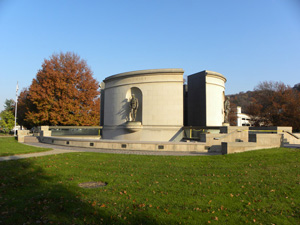

Remember...
Monzel Barker
1920-1945
"The legacy of heroes is the memory of a great name and the inheritance of a great example."
Benjamin Disraeli
 |
Remember...Monzel Barker
|
Army Sergeant Monzel Barker was born on January 9, 1920, in Volga, West Virginia, an unincorporated community southwest of Philippi. His parents were Clyde Barker, a coal miner, and Elva Myrtle Poling Barker. Clyde and Elva's large family consisted of, in addition to Monzel, Loretta May, Glenwood, Willard, Clyde Earl "Junior," Claude, Paul Monk Blair, Theodore Benjamin, Louie Jim, Robert Lynn, and Marjie Jean. Monzel, being the oldest of eleven children, likely began working from a fairly young age to help support the family. Varying recorded locations through the years indicate the Barker family moved around often, yet always stayed within Barbour County. Before his enlistment in the military, Monzel Barker worked in the coal mines, primarily in semiskilled labor and operating machinery. Not much information on Monzel's family, schooling, or early life is available, and reconstructing this period of his life was made difficult.
Monzel Barker enlisted in the U.S. Army in Columbus, Ohio, in 1942. He would be assigned to the 33rd Armored Regiment of the 3rd Armored Division. This unit, also known by its call sign "Orchard," was an original "Spearhead" unit and one of the first Allied fighting machines to capture a German town. The "Men of War" of the 33rd Armored Regiment would emerge from World War II with a reputation for their phenomenal fighting ability. (Source: 3rd Armored Division History, "Division Units," Spearhead in the West, 1946, Web, accessed 5 Apr. 2015.) The unit remained in England for training and preparation until June 24, 1944, when they entered combat at Omaha Beach, Normandy. The 3rd Armored Division continued moving through France and Belgium for the next three months before finally entering Germany in September. (Source: 3rd Armored Division History, "Chronology of Key Events," Web, accessed 5 Apr. 2015.)
A notorious battle involving the 3rd Armored Division was the Battle of H rtgen Forest. Located east of Aachen, Germany, this grueling campaign lasted from September to December 1944. American military leaders originally intended for troops to take the forest quickly and use it to advance towards the Rhine River, but the harsh winter paired with incredibly destructive German military strategy instead created one of the most costly battles of the war with very little reward. Constant freezing and thawing of the ground created major complications for troop movements. Thousands fell victim to disease in just a few months of action. Countless more met their ends at the hands of the German army, who used mines on the ground and artillery strikes in the air to devastate the advancing soldiers. Explosions of artillery shells in the treetops of the forest became a notoriously destructive factor of the fighting as they rained shrapnel and debris onto troops below. Many surviving troops did so after learning that the best defense from these attacks was to "hug the trees" in order to minimize exposure whenever the strikes took place. When all was said and done, more than 24,000 of the 120,000 American fighters were killed, missing, captured, or wounded. Twenty-eight thousand German troops became casualties as well. The American victory in H rtgen Forest had no real strategic value besides the huge losses incurred to the German army. Although it is mostly overshadowed by the Allied victory in the Battle of the Bulge, the Battle of H rtgen Forest is remembered by many as a costly blunder in American military strategy. (Source: "The Story," The Battle of H rtgen Forest: World War II, Web, accessed 5 Apr. 2015.)
Monzel Barker's apparent survival of the Battle of H rtgen Forest was a feat in and of itself. After the battle ended, the 3rd Armored Division returned to Belgium to continue the Battle of the Bulge. After the battle ended in January of 1945, the 3rd Armored Division continued its advance through Germany until it finally crossed the Rhine River on March 21. The division spent roughly eight days advancing farther into Germany before arriving in Paderborn.
On March 30, 1945, Major General Maurice Rose was driving near Paderborn, Germany, in a convoy that included two jeeps, a tank, an armored car, and a motorcycle. During the drive, the convoy encountered several German tanks. The American tank was destroyed early in the fighting that ensued, and Major General Rose was killed shortly thereafter. (Source: Paul Leopold, "The Death of General Rose," 3rd Armored Division History, Web, 5 Apr. 2015.) Monzel Barker's known date of death was on this day, and his last MOS (military occupational specialty) was tank crewman. It is believed that Monzel was working in the tank that was destroyed in this fighting and that this is how he was killed. He was twenty-five years old.
Article prepared by Jordan Nistendirk, George Washington High School, Advanced Placement U.S. History
May 2015

West Virginia Archives and History welcomes any additional information that can be provided about these veterans, including photographs, family names, letters and other relevant personal history.